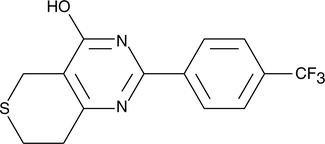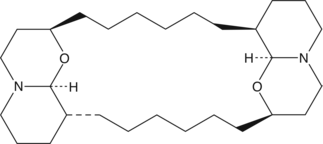Chemicals
Showing 40201–40350 of 41137 results
-
Xanthotoxol is a coumarin and a major component in C. monnieri that has diverse biological activities.{47083,45339,45340,45341,45342} It inhibits proliferation of HeLa and HepG2 cells in vitro (IC50s = 23.59 and 15.57 μM, respectively).{47083} Xanthotoxol increases histamine release from mast cells and decreases secretion of TNF-α, IL-4, and IL-1β from RBL-2H3 cells induced by DNP-human serum albumin (DNP-HSA).{45339} It is nematocidal against M. incognita (IC50 = 68 mg/L).{45340} In vivo, xanthotoxol inhibits predatory mouse and rat killing behavior in dogs and cats when administered at doses ranging from 3 to 100 mg/kg and 5 to 20 mg/kg, respectively.{45341} It reduces amphetamine-induced hypermobility in mice and hamsters. Xanthotoxol (5 and 10 mg/kg) reduces brain edema, neutrophil infiltration, blood-brain barrier disruption, production of IL-1β, TNF-α, IL-8, and nitric oxide (NO), and levels of intercellular adhesion molecule-1 (ICAM-1) and E-selectin in a rat model of focal cerebral ischemia.{45342}
Brand:CaymanSKU:27801 - 25 mgAvailable on backorder
Xanthotoxol is a coumarin and a major component in C. monnieri that has diverse biological activities.{47083,45339,45340,45341,45342} It inhibits proliferation of HeLa and HepG2 cells in vitro (IC50s = 23.59 and 15.57 μM, respectively).{47083} Xanthotoxol increases histamine release from mast cells and decreases secretion of TNF-α, IL-4, and IL-1β from RBL-2H3 cells induced by DNP-human serum albumin (DNP-HSA).{45339} It is nematocidal against M. incognita (IC50 = 68 mg/L).{45340} In vivo, xanthotoxol inhibits predatory mouse and rat killing behavior in dogs and cats when administered at doses ranging from 3 to 100 mg/kg and 5 to 20 mg/kg, respectively.{45341} It reduces amphetamine-induced hypermobility in mice and hamsters. Xanthotoxol (5 and 10 mg/kg) reduces brain edema, neutrophil infiltration, blood-brain barrier disruption, production of IL-1β, TNF-α, IL-8, and nitric oxide (NO), and levels of intercellular adhesion molecule-1 (ICAM-1) and E-selectin in a rat model of focal cerebral ischemia.{45342}
Brand:CaymanSKU:27801 - 5 mgAvailable on backorder
Xanthurenic acid is formed upon tryptophan degradation by indoleamine 2,3-dioxygenase. It has been shown to be an endogenous Group II metabotropic glutamate receptor (mGluR2 and mGluR3) agonist and is implicated in the pathophysiology of schizophrenia.{31730,31731} Xanthurenic acid has also been identified as an inducer of gametogenesis of P. falciparum, the parasite that causes malaria, and thus, is a target for the development of new methods to interrupt the transmission of malaria.{6156}
Brand:CaymanSKU:-Available on backorder
Xanthurenic acid is formed upon tryptophan degradation by indoleamine 2,3-dioxygenase. It has been shown to be an endogenous Group II metabotropic glutamate receptor (mGluR2 and mGluR3) agonist and is implicated in the pathophysiology of schizophrenia.{31730,31731} Xanthurenic acid has also been identified as an inducer of gametogenesis of P. falciparum, the parasite that causes malaria, and thus, is a target for the development of new methods to interrupt the transmission of malaria.{6156}
Brand:CaymanSKU:-Available on backorder
Xanthurenic acid is formed upon tryptophan degradation by indoleamine 2,3-dioxygenase. It has been shown to be an endogenous Group II metabotropic glutamate receptor (mGluR2 and mGluR3) agonist and is implicated in the pathophysiology of schizophrenia.{31730,31731} Xanthurenic acid has also been identified as an inducer of gametogenesis of P. falciparum, the parasite that causes malaria, and thus, is a target for the development of new methods to interrupt the transmission of malaria.{6156}
Brand:CaymanSKU:-Available on backorder
Xanthurenic acid is formed upon tryptophan degradation by indoleamine 2,3-dioxygenase. It has been shown to be an endogenous Group II metabotropic glutamate receptor (mGluR2 and mGluR3) agonist and is implicated in the pathophysiology of schizophrenia.{31730,31731} Xanthurenic acid has also been identified as an inducer of gametogenesis of P. falciparum, the parasite that causes malaria, and thus, is a target for the development of new methods to interrupt the transmission of malaria.{6156}
Brand:CaymanSKU:-Available on backorder
Xanthyletin is a coumarin that has been found in Z. avicennae and has diverse biological activities, including antifungal, antioxidant, and anticancer properties.{52299,52300,52301} It is active against the fungi R. solani, F. graminearum, and P. oryzae (IC50s = 49.1, 117.2, and 31.6 mg/L, respectively).{52299} Xanthyletin (50 mg/L) is also active against F. oxysporum, A. solani, and S. sclerotiorum. It reduces LPS-induced production of nitric oxide (NO) in BV-2 microglial cells with an IC50 value of 5.4 µM.{52300} Xanthyletin inhibits proliferation of A549 lung, MCF-7 breast, and PC3 prostate cancer cells (IC50s = 80.1, 19.3, and 97.2 µg/ml, respectively).{52301}
Brand:CaymanSKU:29929 - 1 mgAvailable on backorder
Xanthyletin is a coumarin that has been found in Z. avicennae and has diverse biological activities, including antifungal, antioxidant, and anticancer properties.{52299,52300,52301} It is active against the fungi R. solani, F. graminearum, and P. oryzae (IC50s = 49.1, 117.2, and 31.6 mg/L, respectively).{52299} Xanthyletin (50 mg/L) is also active against F. oxysporum, A. solani, and S. sclerotiorum. It reduces LPS-induced production of nitric oxide (NO) in BV-2 microglial cells with an IC50 value of 5.4 µM.{52300} Xanthyletin inhibits proliferation of A549 lung, MCF-7 breast, and PC3 prostate cancer cells (IC50s = 80.1, 19.3, and 97.2 µg/ml, respectively).{52301}
Brand:CaymanSKU:29929 - 5 mgAvailable on backorder
XAP044 is an antagonist of the metabotropic glutamate (mGlu) receptor 7 (mGluR7), inhibiting lateral amygdala long term potentiation in brain slices from wild-type mice with an IC50 value of 88 nM.{30926} This effect is absent in mGluR7-deficient mice. XAP044 demonstrates good brain penetrance, producing wide spectrum anti-stress and antidepressant- and anxiolytic-like efficacy in rodent behavioral tests.{30926}
Brand:CaymanSKU:-Available on backorder
XAP044 is an antagonist of the metabotropic glutamate (mGlu) receptor 7 (mGluR7), inhibiting lateral amygdala long term potentiation in brain slices from wild-type mice with an IC50 value of 88 nM.{30926} This effect is absent in mGluR7-deficient mice. XAP044 demonstrates good brain penetrance, producing wide spectrum anti-stress and antidepressant- and anxiolytic-like efficacy in rodent behavioral tests.{30926}
Brand:CaymanSKU:-Available on backorder
XAP044 is an antagonist of the metabotropic glutamate (mGlu) receptor 7 (mGluR7), inhibiting lateral amygdala long term potentiation in brain slices from wild-type mice with an IC50 value of 88 nM.{30926} This effect is absent in mGluR7-deficient mice. XAP044 demonstrates good brain penetrance, producing wide spectrum anti-stress and antidepressant- and anxiolytic-like efficacy in rodent behavioral tests.{30926}
Brand:CaymanSKU:-Available on backorder
The Wnt signaling pathway is integral to normal biological processes and inappropriately active in many cancers. It is regulated through degradation of the downstream effector β-catenin via a complex consisting of the tumor suppressor APC, axin, and glycogen synthase kinase 3 (GSK3). Axin is the concentration-limiting factor for this degradation complex. Initially indentified as telomere-associated proteins{6770}, tankyrases promote axin ubiquitination, possibly through poly-ADP-ribosylation (PARsylation).{17502} XAV939 is a potent, small molecule inhibitor of tankyrase (TNKS) 1 and 2 with IC50 values of 11 and 4 nM, respectively.{17502} By inhibiting TNKS activity, XAV939 increases the protein levels of the axin-GSK3β complex and promotes the degradation of β-catenin in SW480 cells.{17502} At concentrations as low as 0.33 µM, XAV939 inhibits colony formation of APC-deficient colorectal cancer cells.{17502}
Brand:CaymanSKU:-The Wnt signaling pathway is integral to normal biological processes and inappropriately active in many cancers. It is regulated through degradation of the downstream effector β-catenin via a complex consisting of the tumor suppressor APC, axin, and glycogen synthase kinase 3 (GSK3). Axin is the concentration-limiting factor for this degradation complex. Initially indentified as telomere-associated proteins{6770}, tankyrases promote axin ubiquitination, possibly through poly-ADP-ribosylation (PARsylation).{17502} XAV939 is a potent, small molecule inhibitor of tankyrase (TNKS) 1 and 2 with IC50 values of 11 and 4 nM, respectively.{17502} By inhibiting TNKS activity, XAV939 increases the protein levels of the axin-GSK3β complex and promotes the degradation of β-catenin in SW480 cells.{17502} At concentrations as low as 0.33 µM, XAV939 inhibits colony formation of APC-deficient colorectal cancer cells.{17502}
Brand:CaymanSKU:-The Wnt signaling pathway is integral to normal biological processes and inappropriately active in many cancers. It is regulated through degradation of the downstream effector β-catenin via a complex consisting of the tumor suppressor APC, axin, and glycogen synthase kinase 3 (GSK3). Axin is the concentration-limiting factor for this degradation complex. Initially indentified as telomere-associated proteins{6770}, tankyrases promote axin ubiquitination, possibly through poly-ADP-ribosylation (PARsylation).{17502} XAV939 is a potent, small molecule inhibitor of tankyrase (TNKS) 1 and 2 with IC50 values of 11 and 4 nM, respectively.{17502} By inhibiting TNKS activity, XAV939 increases the protein levels of the axin-GSK3β complex and promotes the degradation of β-catenin in SW480 cells.{17502} At concentrations as low as 0.33 µM, XAV939 inhibits colony formation of APC-deficient colorectal cancer cells.{17502}
Brand:CaymanSKU:-The Wnt signaling pathway is integral to normal biological processes and inappropriately active in many cancers. It is regulated through degradation of the downstream effector β-catenin via a complex consisting of the tumor suppressor APC, axin, and glycogen synthase kinase 3 (GSK3). Axin is the concentration-limiting factor for this degradation complex. Initially indentified as telomere-associated proteins{6770}, tankyrases promote axin ubiquitination, possibly through poly-ADP-ribosylation (PARsylation).{17502} XAV939 is a potent, small molecule inhibitor of tankyrase (TNKS) 1 and 2 with IC50 values of 11 and 4 nM, respectively.{17502} By inhibiting TNKS activity, XAV939 increases the protein levels of the axin-GSK3β complex and promotes the degradation of β-catenin in SW480 cells.{17502} At concentrations as low as 0.33 µM, XAV939 inhibits colony formation of APC-deficient colorectal cancer cells.{17502}
Brand:CaymanSKU:-XCT790 is an inverse agonist of estrogen-related receptor α (ERRα; IC50 = ~300-500 nM).{31192,31194} It demonstrates 90-100% inhibition of ERRα constitutive activity and has no significant activity at related nuclear receptors at 10 µM.{31194} XCT790 associates with the ligand-binding domain of ERRα and blocks ERRα/PGC-1α-dependent signaling, suppressing the expression of monoamine oxidases A and B.{31194} XCT790 induces proteasomal degradation of ERRα and potentiates the degradation of the estrogen receptor ERα by fulvestrant (Item No. 10011269).{31193}
Brand:CaymanSKU:-XCT790 is an inverse agonist of estrogen-related receptor α (ERRα; IC50 = ~300-500 nM).{31192,31194} It demonstrates 90-100% inhibition of ERRα constitutive activity and has no significant activity at related nuclear receptors at 10 µM.{31194} XCT790 associates with the ligand-binding domain of ERRα and blocks ERRα/PGC-1α-dependent signaling, suppressing the expression of monoamine oxidases A and B.{31194} XCT790 induces proteasomal degradation of ERRα and potentiates the degradation of the estrogen receptor ERα by fulvestrant (Item No. 10011269).{31193}
Brand:CaymanSKU:-XCT790 is an inverse agonist of estrogen-related receptor α (ERRα; IC50 = ~300-500 nM).{31192,31194} It demonstrates 90-100% inhibition of ERRα constitutive activity and has no significant activity at related nuclear receptors at 10 µM.{31194} XCT790 associates with the ligand-binding domain of ERRα and blocks ERRα/PGC-1α-dependent signaling, suppressing the expression of monoamine oxidases A and B.{31194} XCT790 induces proteasomal degradation of ERRα and potentiates the degradation of the estrogen receptor ERα by fulvestrant (Item No. 10011269).{31193}
Brand:CaymanSKU:-XD14 is a bromodomain-containing protein (BRD) inhibitor.{58146} It binds to BRD2, -3, and -4 (Kds = 170, 380, and 160 nM) and inhibits the growth of HL-60 cells (GI50 = ~20 µM). XD14 (10 µM) also inhibits the growth of SR, K562, and MOLT-4 leukemia cells, as well as T47D breast, UO-31 renal, IGROV-1 ovarian, and KM12 colon cancer cells in vitro.
Brand:CaymanSKU:30740 - 10 mgAvailable on backorder
XD14 is a bromodomain-containing protein (BRD) inhibitor.{58146} It binds to BRD2, -3, and -4 (Kds = 170, 380, and 160 nM) and inhibits the growth of HL-60 cells (GI50 = ~20 µM). XD14 (10 µM) also inhibits the growth of SR, K562, and MOLT-4 leukemia cells, as well as T47D breast, UO-31 renal, IGROV-1 ovarian, and KM12 colon cancer cells in vitro.
Brand:CaymanSKU:30740 - 25 mgAvailable on backorder
XD14 is a bromodomain-containing protein (BRD) inhibitor.{58146} It binds to BRD2, -3, and -4 (Kds = 170, 380, and 160 nM) and inhibits the growth of HL-60 cells (GI50 = ~20 µM). XD14 (10 µM) also inhibits the growth of SR, K562, and MOLT-4 leukemia cells, as well as T47D breast, UO-31 renal, IGROV-1 ovarian, and KM12 colon cancer cells in vitro.
Brand:CaymanSKU:30740 - 5 mgAvailable on backorder
XD14 is a bromodomain-containing protein (BRD) inhibitor.{58146} It binds to BRD2, -3, and -4 (Kds = 170, 380, and 160 nM) and inhibits the growth of HL-60 cells (GI50 = ~20 µM). XD14 (10 µM) also inhibits the growth of SR, K562, and MOLT-4 leukemia cells, as well as T47D breast, UO-31 renal, IGROV-1 ovarian, and KM12 colon cancer cells in vitro.
Brand:CaymanSKU:30740 - 50 mgAvailable on backorder
The KCNQ potassium channels are neuronal modulators which combine with other KQT or KCNE channels to form heteromultimers. XE 991 is a blocker of KCNQ channels that potently inhibits KCNQ1 and 2 homomeric channels (IC50 = 0.75 and 0.71 µM, respectively) as well as KCNQ2+3 heteromultimers (IC50 = 0.6 µM).{23046} It much less effectively blocks eag, erg, and elk channels. The effectiveness of XE 991 against KCNQ channels depends on partners or accessory proteins.{23045} Through these actions, XE 991 enhances acetylcholine release from rat brain slices (EC50 = 490 nM) and shows good in vivo potency and duration of action, suggesting utility in Alzheimer’s disease therapeutics.{23047} While early studies focused on actions in the central nervous system, XE 991 can be used to explore the roles of KCNQ channels in neuronal regulation throughout the body.{23048}
Brand:CaymanSKU:-The KCNQ potassium channels are neuronal modulators which combine with other KQT or KCNE channels to form heteromultimers. XE 991 is a blocker of KCNQ channels that potently inhibits KCNQ1 and 2 homomeric channels (IC50 = 0.75 and 0.71 µM, respectively) as well as KCNQ2+3 heteromultimers (IC50 = 0.6 µM).{23046} It much less effectively blocks eag, erg, and elk channels. The effectiveness of XE 991 against KCNQ channels depends on partners or accessory proteins.{23045} Through these actions, XE 991 enhances acetylcholine release from rat brain slices (EC50 = 490 nM) and shows good in vivo potency and duration of action, suggesting utility in Alzheimer’s disease therapeutics.{23047} While early studies focused on actions in the central nervous system, XE 991 can be used to explore the roles of KCNQ channels in neuronal regulation throughout the body.{23048}
Brand:CaymanSKU:-The KCNQ potassium channels are neuronal modulators which combine with other KQT or KCNE channels to form heteromultimers. XE 991 is a blocker of KCNQ channels that potently inhibits KCNQ1 and 2 homomeric channels (IC50 = 0.75 and 0.71 µM, respectively) as well as KCNQ2+3 heteromultimers (IC50 = 0.6 µM).{23046} It much less effectively blocks eag, erg, and elk channels. The effectiveness of XE 991 against KCNQ channels depends on partners or accessory proteins.{23045} Through these actions, XE 991 enhances acetylcholine release from rat brain slices (EC50 = 490 nM) and shows good in vivo potency and duration of action, suggesting utility in Alzheimer’s disease therapeutics.{23047} While early studies focused on actions in the central nervous system, XE 991 can be used to explore the roles of KCNQ channels in neuronal regulation throughout the body.{23048}
Brand:CaymanSKU:-Endothelial lipase, a member of the triglyceride lipase gene family expressed in endothelial cells, prefers phospholipid-enriched high-density lipoprotein (HDL) over triglyceride as a substrate. XEN445 is an endothelial lipase inhibitor (IC50 = 237 nM) that demonstrates selectivity for endothelial lipase compared to lipoprotein and hepatic lipases (IC50s = 20 and 9.5 µM, respectivley).{31026} An oral dose of 30 mg/kg XEN445 is reported to increase HDL cholesterol concentrations by 16% after three days and by 30% after nine days dosing in wild-type mice.{31026}
Brand:CaymanSKU:-Available on backorder
Endothelial lipase, a member of the triglyceride lipase gene family expressed in endothelial cells, prefers phospholipid-enriched high-density lipoprotein (HDL) over triglyceride as a substrate. XEN445 is an endothelial lipase inhibitor (IC50 = 237 nM) that demonstrates selectivity for endothelial lipase compared to lipoprotein and hepatic lipases (IC50s = 20 and 9.5 µM, respectivley).{31026} An oral dose of 30 mg/kg XEN445 is reported to increase HDL cholesterol concentrations by 16% after three days and by 30% after nine days dosing in wild-type mice.{31026}
Brand:CaymanSKU:-Available on backorder
Endothelial lipase, a member of the triglyceride lipase gene family expressed in endothelial cells, prefers phospholipid-enriched high-density lipoprotein (HDL) over triglyceride as a substrate. XEN445 is an endothelial lipase inhibitor (IC50 = 237 nM) that demonstrates selectivity for endothelial lipase compared to lipoprotein and hepatic lipases (IC50s = 20 and 9.5 µM, respectivley).{31026} An oral dose of 30 mg/kg XEN445 is reported to increase HDL cholesterol concentrations by 16% after three days and by 30% after nine days dosing in wild-type mice.{31026}
Brand:CaymanSKU:-Available on backorder
Xenopsin is a neurotensin-like octapeptide that has been found in X. laevis skin.{46783} It inhibits neurotensin (Item No. 24717) binding to rat brain synaptic membranes (Ki = 1.5 nM) and induces contraction of isolated guinea pig ileum in the presence of neostigmine (Item No. 23501; EC50 = 9 nM).{38912} Xenopsin (0.1 μM) increases the firing rate of dopaminergic neurons in rat substantia nigra slices by 58.5%.{46784} Intravenous infusion of xenopsin (2 μg/kg per hour) increases adrenal, pancreatic, and ileal blood flow and plasma levels of pancreatic polypeptide, glucagon, substance P, and cortisol, as well as reduces tetragastrin-induced gastric acid secretion in dogs.{46783}
Brand:CaymanSKU:29968 - 1 mgAvailable on backorder
Xenopsin is a neurotensin-like octapeptide that has been found in X. laevis skin.{46783} It inhibits neurotensin (Item No. 24717) binding to rat brain synaptic membranes (Ki = 1.5 nM) and induces contraction of isolated guinea pig ileum in the presence of neostigmine (Item No. 23501; EC50 = 9 nM).{38912} Xenopsin (0.1 μM) increases the firing rate of dopaminergic neurons in rat substantia nigra slices by 58.5%.{46784} Intravenous infusion of xenopsin (2 μg/kg per hour) increases adrenal, pancreatic, and ileal blood flow and plasma levels of pancreatic polypeptide, glucagon, substance P, and cortisol, as well as reduces tetragastrin-induced gastric acid secretion in dogs.{46783}
Brand:CaymanSKU:29968 - 10 mgAvailable on backorder
Xenopsin is a neurotensin-like octapeptide that has been found in X. laevis skin.{46783} It inhibits neurotensin (Item No. 24717) binding to rat brain synaptic membranes (Ki = 1.5 nM) and induces contraction of isolated guinea pig ileum in the presence of neostigmine (Item No. 23501; EC50 = 9 nM).{38912} Xenopsin (0.1 μM) increases the firing rate of dopaminergic neurons in rat substantia nigra slices by 58.5%.{46784} Intravenous infusion of xenopsin (2 μg/kg per hour) increases adrenal, pancreatic, and ileal blood flow and plasma levels of pancreatic polypeptide, glucagon, substance P, and cortisol, as well as reduces tetragastrin-induced gastric acid secretion in dogs.{46783}
Brand:CaymanSKU:29968 - 5 mgAvailable on backorder
Xestospongin C is a marine natural product which was first isolated from Pacific basin sponges, and noted to have vasodilatory properties.{9844} Xestospongin C antagonizes the calcium-releasing action of inositol-1,4,5-trisphosphate (IP3) at the receptor level. Inositol phosphates are important signal transduction messengers acting via IP3 receptors to promote the mobilization of Ca2+ from intracellular stores. Xestospongin C blocks the increase in intracellular calcium in vascular smooth muscle cells completely at a concentration of 25 µM.{9845} Xestospongin C also inhibits the sarcoplasmic reticulum Ca2+ ATPase pump at concentrations of 700 nM.{10509}
Brand:CaymanSKU:64950 - 10 µgAvailable on backorder
Xestospongin C is a marine natural product which was first isolated from Pacific basin sponges, and noted to have vasodilatory properties.{9844} Xestospongin C antagonizes the calcium-releasing action of inositol-1,4,5-trisphosphate (IP3) at the receptor level. Inositol phosphates are important signal transduction messengers acting via IP3 receptors to promote the mobilization of Ca2+ from intracellular stores. Xestospongin C blocks the increase in intracellular calcium in vascular smooth muscle cells completely at a concentration of 25 µM.{9845} Xestospongin C also inhibits the sarcoplasmic reticulum Ca2+ ATPase pump at concentrations of 700 nM.{10509}
Brand:CaymanSKU:64950 - 100 µgAvailable on backorder
Xestospongin C is a marine natural product which was first isolated from Pacific basin sponges, and noted to have vasodilatory properties.{9844} Xestospongin C antagonizes the calcium-releasing action of inositol-1,4,5-trisphosphate (IP3) at the receptor level. Inositol phosphates are important signal transduction messengers acting via IP3 receptors to promote the mobilization of Ca2+ from intracellular stores. Xestospongin C blocks the increase in intracellular calcium in vascular smooth muscle cells completely at a concentration of 25 µM.{9845} Xestospongin C also inhibits the sarcoplasmic reticulum Ca2+ ATPase pump at concentrations of 700 nM.{10509}
Brand:CaymanSKU:64950 - 250 µgAvailable on backorder
Xestospongin C is a marine natural product which was first isolated from Pacific basin sponges, and noted to have vasodilatory properties.{9844} Xestospongin C antagonizes the calcium-releasing action of inositol-1,4,5-trisphosphate (IP3) at the receptor level. Inositol phosphates are important signal transduction messengers acting via IP3 receptors to promote the mobilization of Ca2+ from intracellular stores. Xestospongin C blocks the increase in intracellular calcium in vascular smooth muscle cells completely at a concentration of 25 µM.{9845} Xestospongin C also inhibits the sarcoplasmic reticulum Ca2+ ATPase pump at concentrations of 700 nM.{10509}
Brand:CaymanSKU:64950 - 50 µgAvailable on backorder
Ximelagatran is an ester prodrug of melagatran, a potent, direct, and reversible thrombin inhibitor (Ki = 1.2 nM).{27703,27704} While melagatran has poor oral bioavailability, ximelagatran displays good bioavailability resulting, in part, from rapid absorption at the gastrointestinal tract, as well as rapid onset of action.{27704} Ximelagatran is converted to melagatran by reduction and hydrolysis at the liver and other tissues.{27703,27704} It is used as an anticoagulant in a variety of situations, including thromboembolic disorders, stroke prevention in atrial fibrillation, and therapy in vein thrombosis.{27704,15996}
Brand:CaymanSKU:-Out of stock
Ximelagatran is an ester prodrug of melagatran, a potent, direct, and reversible thrombin inhibitor (Ki = 1.2 nM).{27703,27704} While melagatran has poor oral bioavailability, ximelagatran displays good bioavailability resulting, in part, from rapid absorption at the gastrointestinal tract, as well as rapid onset of action.{27704} Ximelagatran is converted to melagatran by reduction and hydrolysis at the liver and other tissues.{27703,27704} It is used as an anticoagulant in a variety of situations, including thromboembolic disorders, stroke prevention in atrial fibrillation, and therapy in vein thrombosis.{27704,15996}
Brand:CaymanSKU:-Out of stock
Ximelagatran is an ester prodrug of melagatran, a potent, direct, and reversible thrombin inhibitor (Ki = 1.2 nM).{27703,27704} While melagatran has poor oral bioavailability, ximelagatran displays good bioavailability resulting, in part, from rapid absorption at the gastrointestinal tract, as well as rapid onset of action.{27704} Ximelagatran is converted to melagatran by reduction and hydrolysis at the liver and other tissues.{27703,27704} It is used as an anticoagulant in a variety of situations, including thromboembolic disorders, stroke prevention in atrial fibrillation, and therapy in vein thrombosis.{27704,15996}
Brand:CaymanSKU:-Out of stock
Janus-associated kinases (JAKs) are cytoplasmic tyrosine kinases that are required for activating the signaling of certain cytokines and growth factor receptors. Many myeloproliferative diseases have been linked to a mutation in JAK2 where a switch from valine to phenylalanine occurs at the 617 position (V617F).{27171} Furthermore, constitutive activation of the JAK2 signaling pathway is associated with aggressive adult T cell leukemia/lymphoma.{27172} XL019 is a potent, bioavailable JAK inhibitor with preference for JAK2 (IC50 = 2 nM) over JAK1 and JAK3 (IC50s = 130 and 250 nM, respectively).{27725,21781} It is effective against JAK2V617F as well as JAK2 and inhibits phosphorylation of STAT5 in vivo.{27397}
Brand:CaymanSKU:-Out of stock
Janus-associated kinases (JAKs) are cytoplasmic tyrosine kinases that are required for activating the signaling of certain cytokines and growth factor receptors. Many myeloproliferative diseases have been linked to a mutation in JAK2 where a switch from valine to phenylalanine occurs at the 617 position (V617F).{27171} Furthermore, constitutive activation of the JAK2 signaling pathway is associated with aggressive adult T cell leukemia/lymphoma.{27172} XL019 is a potent, bioavailable JAK inhibitor with preference for JAK2 (IC50 = 2 nM) over JAK1 and JAK3 (IC50s = 130 and 250 nM, respectively).{27725,21781} It is effective against JAK2V617F as well as JAK2 and inhibits phosphorylation of STAT5 in vivo.{27397}
Brand:CaymanSKU:-Out of stock
Janus-associated kinases (JAKs) are cytoplasmic tyrosine kinases that are required for activating the signaling of certain cytokines and growth factor receptors. Many myeloproliferative diseases have been linked to a mutation in JAK2 where a switch from valine to phenylalanine occurs at the 617 position (V617F).{27171} Furthermore, constitutive activation of the JAK2 signaling pathway is associated with aggressive adult T cell leukemia/lymphoma.{27172} XL019 is a potent, bioavailable JAK inhibitor with preference for JAK2 (IC50 = 2 nM) over JAK1 and JAK3 (IC50s = 130 and 250 nM, respectively).{27725,21781} It is effective against JAK2V617F as well as JAK2 and inhibits phosphorylation of STAT5 in vivo.{27397}
Brand:CaymanSKU:-Out of stock
Janus-associated kinases (JAKs) are cytoplasmic tyrosine kinases that are required for activating the signaling of certain cytokines and growth factor receptors. Many myeloproliferative diseases have been linked to a mutation in JAK2 where a switch from valine to phenylalanine occurs at the 617 position (V617F).{27171} Furthermore, constitutive activation of the JAK2 signaling pathway is associated with aggressive adult T cell leukemia/lymphoma.{27172} XL019 is a potent, bioavailable JAK inhibitor with preference for JAK2 (IC50 = 2 nM) over JAK1 and JAK3 (IC50s = 130 and 250 nM, respectively).{27725,21781} It is effective against JAK2V617F as well as JAK2 and inhibits phosphorylation of STAT5 in vivo.{27397}
Brand:CaymanSKU:-Out of stock
The phosphatidylinositol 3-kinase (PI3K) signaling pathway has central roles in cell growth, development, and survival. XL147 is a methylbenzenesulfonamide derivative that reversibly inhibits class I PI3Ks (IC50s = 39, 36, 23, and 383 nM for p110α, δ, γ, and β, respectively).{29152} It has been shown to abrogate Akt and S6 kinase phosphorylation, reduce cyclin D1 and retinoblastoma protein, and upregulate the CDK inhibitor p27, inhibiting cell proliferation.{29152} In HER2-overexpressing breast cancer cells, cotreatment with the HER2 inhibitors trastuzumab or lapatinib (Item No. 11493) are reported to sensitize tumor cells to the growth inhibitory effect of XL147.{29153} This compound has been evaluated in clinical trials in patients with advanced solid tumors.{29154}
Brand:CaymanSKU:-Available on backorder
The phosphatidylinositol 3-kinase (PI3K) signaling pathway has central roles in cell growth, development, and survival. XL147 is a methylbenzenesulfonamide derivative that reversibly inhibits class I PI3Ks (IC50s = 39, 36, 23, and 383 nM for p110α, δ, γ, and β, respectively).{29152} It has been shown to abrogate Akt and S6 kinase phosphorylation, reduce cyclin D1 and retinoblastoma protein, and upregulate the CDK inhibitor p27, inhibiting cell proliferation.{29152} In HER2-overexpressing breast cancer cells, cotreatment with the HER2 inhibitors trastuzumab or lapatinib (Item No. 11493) are reported to sensitize tumor cells to the growth inhibitory effect of XL147.{29153} This compound has been evaluated in clinical trials in patients with advanced solid tumors.{29154}
Brand:CaymanSKU:-Available on backorder
The phosphatidylinositol 3-kinase (PI3K) signaling pathway has central roles in cell growth, development, and survival. XL147 is a methylbenzenesulfonamide derivative that reversibly inhibits class I PI3Ks (IC50s = 39, 36, 23, and 383 nM for p110α, δ, γ, and β, respectively).{29152} It has been shown to abrogate Akt and S6 kinase phosphorylation, reduce cyclin D1 and retinoblastoma protein, and upregulate the CDK inhibitor p27, inhibiting cell proliferation.{29152} In HER2-overexpressing breast cancer cells, cotreatment with the HER2 inhibitors trastuzumab or lapatinib (Item No. 11493) are reported to sensitize tumor cells to the growth inhibitory effect of XL147.{29153} This compound has been evaluated in clinical trials in patients with advanced solid tumors.{29154}
Brand:CaymanSKU:-Available on backorder
The phosphatidylinositol 3-kinase (PI3K) signaling pathway has central roles in cell growth, development, and survival. XL147 is a methylbenzenesulfonamide derivative that reversibly inhibits class I PI3Ks (IC50s = 39, 36, 23, and 383 nM for p110α, δ, γ, and β, respectively).{29152} It has been shown to abrogate Akt and S6 kinase phosphorylation, reduce cyclin D1 and retinoblastoma protein, and upregulate the CDK inhibitor p27, inhibiting cell proliferation.{29152} In HER2-overexpressing breast cancer cells, cotreatment with the HER2 inhibitors trastuzumab or lapatinib (Item No. 11493) are reported to sensitize tumor cells to the growth inhibitory effect of XL147.{29153} This compound has been evaluated in clinical trials in patients with advanced solid tumors.{29154}
Brand:CaymanSKU:-Available on backorder
XL147 analog is a derivative of XL147 (Item No. 18011), a reversible inhibitor of class I PI3Ks (IC50s = 39, 36, 23, and 383 nM for p110α, δ, γ, and β, respectively).{29152} Biological information regarding XL147 analog has not been published.
Brand:CaymanSKU:20245 -Available on backorder
XL147 analog is a derivative of XL147 (Item No. 18011), a reversible inhibitor of class I PI3Ks (IC50s = 39, 36, 23, and 383 nM for p110α, δ, γ, and β, respectively).{29152} Biological information regarding XL147 analog has not been published.
Brand:CaymanSKU:20245 -Available on backorder
XL147 analog is a derivative of XL147 (Item No. 18011), a reversible inhibitor of class I PI3Ks (IC50s = 39, 36, 23, and 383 nM for p110α, δ, γ, and β, respectively).{29152} Biological information regarding XL147 analog has not been published.
Brand:CaymanSKU:20245 -Available on backorder
XL147 analog is a derivative of XL147 (Item No. 18011), a reversible inhibitor of class I PI3Ks (IC50s = 39, 36, 23, and 383 nM for p110α, δ, γ, and β, respectively).{29152} Biological information regarding XL147 analog has not been published.
Brand:CaymanSKU:20245 -Available on backorder
XL184 is a pan tyrosine kinase inhibitor that primarily targets VEGFR2 (IC50 = 0.035 nM) and c-Met (IC50 = 1.3 nM) but also inhibits RET, c-Kit, Axl, FLT3, and Tie2 (IC50s = 5.2, 4.6, 7, 11.3, and 14.3 nM, respectively).{29857} In in vivo breast, lung, and glioma tumor models that represent dysregulated c-Met and VEGFR signaling, XL184 was shown to reduce tumor and endothelial cell proliferation, inhibiting both angiogenesis and metastasis.{29857} XL184 has undergone clinical trial in a broad number of cancers, including thyroid carcinoma, prostate cancer, ovarian cancer, melanoma, breast cancer, non-small cell lung cancer, hepatocellular cancer, renal cell carcinoma, and glioblastoma.{29858}
Brand:CaymanSKU:-Available on backorder
XL184 is a pan tyrosine kinase inhibitor that primarily targets VEGFR2 (IC50 = 0.035 nM) and c-Met (IC50 = 1.3 nM) but also inhibits RET, c-Kit, Axl, FLT3, and Tie2 (IC50s = 5.2, 4.6, 7, 11.3, and 14.3 nM, respectively).{29857} In in vivo breast, lung, and glioma tumor models that represent dysregulated c-Met and VEGFR signaling, XL184 was shown to reduce tumor and endothelial cell proliferation, inhibiting both angiogenesis and metastasis.{29857} XL184 has undergone clinical trial in a broad number of cancers, including thyroid carcinoma, prostate cancer, ovarian cancer, melanoma, breast cancer, non-small cell lung cancer, hepatocellular cancer, renal cell carcinoma, and glioblastoma.{29858}
Brand:CaymanSKU:-Available on backorder
XL184 is a pan tyrosine kinase inhibitor that primarily targets VEGFR2 (IC50 = 0.035 nM) and c-Met (IC50 = 1.3 nM) but also inhibits RET, c-Kit, Axl, FLT3, and Tie2 (IC50s = 5.2, 4.6, 7, 11.3, and 14.3 nM, respectively).{29857} In in vivo breast, lung, and glioma tumor models that represent dysregulated c-Met and VEGFR signaling, XL184 was shown to reduce tumor and endothelial cell proliferation, inhibiting both angiogenesis and metastasis.{29857} XL184 has undergone clinical trial in a broad number of cancers, including thyroid carcinoma, prostate cancer, ovarian cancer, melanoma, breast cancer, non-small cell lung cancer, hepatocellular cancer, renal cell carcinoma, and glioblastoma.{29858}
Brand:CaymanSKU:-Available on backorder
XL184 is a pan tyrosine kinase inhibitor that primarily targets VEGFR2 (IC50 = 0.035 nM) and c-Met (IC50 = 1.3 nM) but also inhibits RET, c-Kit, Axl, FLT3, and Tie2 (IC50s = 5.2, 4.6, 7, 11.3, and 14.3 nM, respectively).{29857} In in vivo breast, lung, and glioma tumor models that represent dysregulated c-Met and VEGFR signaling, XL184 was shown to reduce tumor and endothelial cell proliferation, inhibiting both angiogenesis and metastasis.{29857} XL184 has undergone clinical trial in a broad number of cancers, including thyroid carcinoma, prostate cancer, ovarian cancer, melanoma, breast cancer, non-small cell lung cancer, hepatocellular cancer, renal cell carcinoma, and glioblastoma.{29858}
Brand:CaymanSKU:-Available on backorder
XL228 potently inhibits the tyrosine kinases IGF1R (IC50 = 1.6 nM) and FGFR1-3 (IC50 50 = 6.1 nM), which mediates metastasis.{33639,33640} It also inhibits the non-receptor tyrosine kinases BCR-ABL (IC50 = 1.4 nM) and Aurora A (IC50 = 3.1 nM), associated with chronic myelogenous leukemia. XL228 showed promising preliminary results in a Phase 1 clinical trial for patients with chronic myelogenous leukemia or Philadelphia-chromosome-positive acute lymphocytic leukemia but the trial was terminated early.{33640}
Brand:CaymanSKU:21506 -Out of stock
XL228 potently inhibits the tyrosine kinases IGF1R (IC50 = 1.6 nM) and FGFR1-3 (IC50 50 = 6.1 nM), which mediates metastasis.{33639,33640} It also inhibits the non-receptor tyrosine kinases BCR-ABL (IC50 = 1.4 nM) and Aurora A (IC50 = 3.1 nM), associated with chronic myelogenous leukemia. XL228 showed promising preliminary results in a Phase 1 clinical trial for patients with chronic myelogenous leukemia or Philadelphia-chromosome-positive acute lymphocytic leukemia but the trial was terminated early.{33640}
Brand:CaymanSKU:21506 -Out of stock
XL228 potently inhibits the tyrosine kinases IGF1R (IC50 = 1.6 nM) and FGFR1-3 (IC50 50 = 6.1 nM), which mediates metastasis.{33639,33640} It also inhibits the non-receptor tyrosine kinases BCR-ABL (IC50 = 1.4 nM) and Aurora A (IC50 = 3.1 nM), associated with chronic myelogenous leukemia. XL228 showed promising preliminary results in a Phase 1 clinical trial for patients with chronic myelogenous leukemia or Philadelphia-chromosome-positive acute lymphocytic leukemia but the trial was terminated early.{33640}
Brand:CaymanSKU:21506 -Out of stock
XL228 potently inhibits the tyrosine kinases IGF1R (IC50 = 1.6 nM) and FGFR1-3 (IC50 50 = 6.1 nM), which mediates metastasis.{33639,33640} It also inhibits the non-receptor tyrosine kinases BCR-ABL (IC50 = 1.4 nM) and Aurora A (IC50 = 3.1 nM), associated with chronic myelogenous leukemia. XL228 showed promising preliminary results in a Phase 1 clinical trial for patients with chronic myelogenous leukemia or Philadelphia-chromosome-positive acute lymphocytic leukemia but the trial was terminated early.{33640}
Brand:CaymanSKU:21506 -Out of stock
XL335 is an orally bioavailable and potent agonist of the farnesoid X receptor (FXR) with an EC50 value of 4 nM in CV-1 cells transfected with human FXR.{37177} It is selective for FXR over a panel of 15 nuclear receptors at concentrations up to 10 μM. XL335 induces expression of mouse intestinal bile acid binding protein (IBABP), human bile salt excretory pump (BSEP), and small heterodimer partner (SHP) genes in reporter gene assays. It also induces a 20-, 13-, and 2-fold increase in mRNA expression for IBABP, BSEP, and SHP, respectively, at a concentration of 1 μM. XL335 (3 mg/kg) reduces plasma cholesterol and triglycerides by 39 and 50%, respectively, and decreases the area of pre-atherosclerotic lesions in LDLR-/- mice fed a Western diet. It also decreases hepatic fibrosis in a mouse model of non-alcoholic steatohepatitis.{37178}
Brand:CaymanSKU:23350 - 10 mgAvailable on backorder
XL335 is an orally bioavailable and potent agonist of the farnesoid X receptor (FXR) with an EC50 value of 4 nM in CV-1 cells transfected with human FXR.{37177} It is selective for FXR over a panel of 15 nuclear receptors at concentrations up to 10 μM. XL335 induces expression of mouse intestinal bile acid binding protein (IBABP), human bile salt excretory pump (BSEP), and small heterodimer partner (SHP) genes in reporter gene assays. It also induces a 20-, 13-, and 2-fold increase in mRNA expression for IBABP, BSEP, and SHP, respectively, at a concentration of 1 μM. XL335 (3 mg/kg) reduces plasma cholesterol and triglycerides by 39 and 50%, respectively, and decreases the area of pre-atherosclerotic lesions in LDLR-/- mice fed a Western diet. It also decreases hepatic fibrosis in a mouse model of non-alcoholic steatohepatitis.{37178}
Brand:CaymanSKU:23350 - 25 mgAvailable on backorder
XL335 is an orally bioavailable and potent agonist of the farnesoid X receptor (FXR) with an EC50 value of 4 nM in CV-1 cells transfected with human FXR.{37177} It is selective for FXR over a panel of 15 nuclear receptors at concentrations up to 10 μM. XL335 induces expression of mouse intestinal bile acid binding protein (IBABP), human bile salt excretory pump (BSEP), and small heterodimer partner (SHP) genes in reporter gene assays. It also induces a 20-, 13-, and 2-fold increase in mRNA expression for IBABP, BSEP, and SHP, respectively, at a concentration of 1 μM. XL335 (3 mg/kg) reduces plasma cholesterol and triglycerides by 39 and 50%, respectively, and decreases the area of pre-atherosclerotic lesions in LDLR-/- mice fed a Western diet. It also decreases hepatic fibrosis in a mouse model of non-alcoholic steatohepatitis.{37178}
Brand:CaymanSKU:23350 - 5 mgAvailable on backorder
XL388 is an orally bioavailable and ATP-competitive inhibitor of mammalian target of rapamycin (mTOR; IC50 = 9.9 nM).{42465} It is selective for mTOR over a panel of more than 140 kinases, including various PI3Ks (IC50s = >3,000 nM). It inhibits mTOR complex 1 (mTORC1) and mTORC2 in vitro (IC50s = 8 and 166 nM, respectively).{42466} XL388 induces cytotoxicity in MG-63, U2OS, and Saos-2 osteosarcoma and 786-0 kidney cancer cells and increases apoptosis in 786-0 and MG-63 cells in a concentration-dependent manner.{31720,42467} It also induces cell cycle arrest at the G1 phase and increases autophagy in MG-63 cells.{31720} XL388 (50 and 100 mg/kg) reduces tumor growth in an MCF-7 breast cancer mouse xenograft model and inhibits phosphorylation of the mTORC1 and mTORC2 substrates p70S6K, S6, 4E-BP1, and Akt in MCF-7 and PC-3 xenograft tumors when administered at a dose of 100 mg/kg.{42465} XL388 (20 mg/kg) also reduces tumor growth in U2OS and 786-0 mouse xenograft models.{31720,42467}
Brand:CaymanSKU:20237 -Available on backorder
XL388 is an orally bioavailable and ATP-competitive inhibitor of mammalian target of rapamycin (mTOR; IC50 = 9.9 nM).{42465} It is selective for mTOR over a panel of more than 140 kinases, including various PI3Ks (IC50s = >3,000 nM). It inhibits mTOR complex 1 (mTORC1) and mTORC2 in vitro (IC50s = 8 and 166 nM, respectively).{42466} XL388 induces cytotoxicity in MG-63, U2OS, and Saos-2 osteosarcoma and 786-0 kidney cancer cells and increases apoptosis in 786-0 and MG-63 cells in a concentration-dependent manner.{31720,42467} It also induces cell cycle arrest at the G1 phase and increases autophagy in MG-63 cells.{31720} XL388 (50 and 100 mg/kg) reduces tumor growth in an MCF-7 breast cancer mouse xenograft model and inhibits phosphorylation of the mTORC1 and mTORC2 substrates p70S6K, S6, 4E-BP1, and Akt in MCF-7 and PC-3 xenograft tumors when administered at a dose of 100 mg/kg.{42465} XL388 (20 mg/kg) also reduces tumor growth in U2OS and 786-0 mouse xenograft models.{31720,42467}
Brand:CaymanSKU:20237 -Available on backorder
XL388 is an orally bioavailable and ATP-competitive inhibitor of mammalian target of rapamycin (mTOR; IC50 = 9.9 nM).{42465} It is selective for mTOR over a panel of more than 140 kinases, including various PI3Ks (IC50s = >3,000 nM). It inhibits mTOR complex 1 (mTORC1) and mTORC2 in vitro (IC50s = 8 and 166 nM, respectively).{42466} XL388 induces cytotoxicity in MG-63, U2OS, and Saos-2 osteosarcoma and 786-0 kidney cancer cells and increases apoptosis in 786-0 and MG-63 cells in a concentration-dependent manner.{31720,42467} It also induces cell cycle arrest at the G1 phase and increases autophagy in MG-63 cells.{31720} XL388 (50 and 100 mg/kg) reduces tumor growth in an MCF-7 breast cancer mouse xenograft model and inhibits phosphorylation of the mTORC1 and mTORC2 substrates p70S6K, S6, 4E-BP1, and Akt in MCF-7 and PC-3 xenograft tumors when administered at a dose of 100 mg/kg.{42465} XL388 (20 mg/kg) also reduces tumor growth in U2OS and 786-0 mouse xenograft models.{31720,42467}
Brand:CaymanSKU:20237 -Available on backorder
XL388 is an orally bioavailable and ATP-competitive inhibitor of mammalian target of rapamycin (mTOR; IC50 = 9.9 nM).{42465} It is selective for mTOR over a panel of more than 140 kinases, including various PI3Ks (IC50s = >3,000 nM). It inhibits mTOR complex 1 (mTORC1) and mTORC2 in vitro (IC50s = 8 and 166 nM, respectively).{42466} XL388 induces cytotoxicity in MG-63, U2OS, and Saos-2 osteosarcoma and 786-0 kidney cancer cells and increases apoptosis in 786-0 and MG-63 cells in a concentration-dependent manner.{31720,42467} It also induces cell cycle arrest at the G1 phase and increases autophagy in MG-63 cells.{31720} XL388 (50 and 100 mg/kg) reduces tumor growth in an MCF-7 breast cancer mouse xenograft model and inhibits phosphorylation of the mTORC1 and mTORC2 substrates p70S6K, S6, 4E-BP1, and Akt in MCF-7 and PC-3 xenograft tumors when administered at a dose of 100 mg/kg.{42465} XL388 (20 mg/kg) also reduces tumor growth in U2OS and 786-0 mouse xenograft models.{31720,42467}
Brand:CaymanSKU:20237 -Available on backorder
XL413 is a potent inhibitor of Cdc7 (IC50 = 3.4 nM).{41765} It is >60, >10, and >300-fold selective for Cdc7 over CK2, PIM1, and a panel of over 100 protein kinases, respectively. XL413 inhibits the growth of MDA-MB-231T and COLO 205 cells (IC50s = 118 and 140 nM, respectively). It inhibits Cdc7-specific phosphorylation of mini-chromosome maintenance protein (MCM2) and induces cell cycle accumulation in the S and G2 phases in MDA-MB-231T and COLO 205 cells that overexpress Cdc7. In vivo, XL413 inhibits MCM2 phosphorylation (ED50 = <3 mg/kg) and reduces tumor growth in a COLO 205 mouse xenograft model when administered orally at doses of 10, 30, and 100 mg/kg.
Brand:CaymanSKU:24906 - 10 mgAvailable on backorder
XL413 is a potent inhibitor of Cdc7 (IC50 = 3.4 nM).{41765} It is >60, >10, and >300-fold selective for Cdc7 over CK2, PIM1, and a panel of over 100 protein kinases, respectively. XL413 inhibits the growth of MDA-MB-231T and COLO 205 cells (IC50s = 118 and 140 nM, respectively). It inhibits Cdc7-specific phosphorylation of mini-chromosome maintenance protein (MCM2) and induces cell cycle accumulation in the S and G2 phases in MDA-MB-231T and COLO 205 cells that overexpress Cdc7. In vivo, XL413 inhibits MCM2 phosphorylation (ED50 = <3 mg/kg) and reduces tumor growth in a COLO 205 mouse xenograft model when administered orally at doses of 10, 30, and 100 mg/kg.
Brand:CaymanSKU:24906 - 25 mgAvailable on backorder
XL413 is a potent inhibitor of Cdc7 (IC50 = 3.4 nM).{41765} It is >60, >10, and >300-fold selective for Cdc7 over CK2, PIM1, and a panel of over 100 protein kinases, respectively. XL413 inhibits the growth of MDA-MB-231T and COLO 205 cells (IC50s = 118 and 140 nM, respectively). It inhibits Cdc7-specific phosphorylation of mini-chromosome maintenance protein (MCM2) and induces cell cycle accumulation in the S and G2 phases in MDA-MB-231T and COLO 205 cells that overexpress Cdc7. In vivo, XL413 inhibits MCM2 phosphorylation (ED50 = <3 mg/kg) and reduces tumor growth in a COLO 205 mouse xenograft model when administered orally at doses of 10, 30, and 100 mg/kg.
Brand:CaymanSKU:24906 - 5 mgAvailable on backorder
XL413 is a potent inhibitor of Cdc7 (IC50 = 3.4 nM).{41765} It is >60, >10, and >300-fold selective for Cdc7 over CK2, PIM1, and a panel of over 100 protein kinases, respectively. XL413 inhibits the growth of MDA-MB-231T and COLO 205 cells (IC50s = 118 and 140 nM, respectively). It inhibits Cdc7-specific phosphorylation of mini-chromosome maintenance protein (MCM2) and induces cell cycle accumulation in the S and G2 phases in MDA-MB-231T and COLO 205 cells that overexpress Cdc7. In vivo, XL413 inhibits MCM2 phosphorylation (ED50 = <3 mg/kg) and reduces tumor growth in a COLO 205 mouse xenograft model when administered orally at doses of 10, 30, and 100 mg/kg.
Brand:CaymanSKU:24906 - 50 mgAvailable on backorder
XL647 is a multi-kinase inhibitor (IC50s = 0.3, 16, 1.5, 8.7, and 1.4 nM for EGFR, ErbB2, KDR, FLT4, and EphB4, respectively).{45304} It is selective for these kinases over a panel of 10 tyrosine kinases and 55 serine/threonine kinases at 10 μM. XL647 inhibits growth of A431 cells expressing wild-type EGFR and H1975 non-small cell lung cancer (NSCLC) cells expressing both the activating mutant EGFRL858R and the drug resistance-associated mutant EGFRT790M (IC50s = 13 and 920 nM, respectively). In vivo, XL647 (10, 30, and 100 mg/kg) inhibits tumor growth and EGFR phosphorylation in an H1975 mouse xenograft model in a dose-dependent manner.
Brand:CaymanSKU:27049 - 1 mgAvailable on backorder
XL647 is a multi-kinase inhibitor (IC50s = 0.3, 16, 1.5, 8.7, and 1.4 nM for EGFR, ErbB2, KDR, FLT4, and EphB4, respectively).{45304} It is selective for these kinases over a panel of 10 tyrosine kinases and 55 serine/threonine kinases at 10 μM. XL647 inhibits growth of A431 cells expressing wild-type EGFR and H1975 non-small cell lung cancer (NSCLC) cells expressing both the activating mutant EGFRL858R and the drug resistance-associated mutant EGFRT790M (IC50s = 13 and 920 nM, respectively). In vivo, XL647 (10, 30, and 100 mg/kg) inhibits tumor growth and EGFR phosphorylation in an H1975 mouse xenograft model in a dose-dependent manner.
Brand:CaymanSKU:27049 - 10 mgAvailable on backorder
XL647 is a multi-kinase inhibitor (IC50s = 0.3, 16, 1.5, 8.7, and 1.4 nM for EGFR, ErbB2, KDR, FLT4, and EphB4, respectively).{45304} It is selective for these kinases over a panel of 10 tyrosine kinases and 55 serine/threonine kinases at 10 μM. XL647 inhibits growth of A431 cells expressing wild-type EGFR and H1975 non-small cell lung cancer (NSCLC) cells expressing both the activating mutant EGFRL858R and the drug resistance-associated mutant EGFRT790M (IC50s = 13 and 920 nM, respectively). In vivo, XL647 (10, 30, and 100 mg/kg) inhibits tumor growth and EGFR phosphorylation in an H1975 mouse xenograft model in a dose-dependent manner.
Brand:CaymanSKU:27049 - 5 mgAvailable on backorder
Phosphatidylinositol 3-kinase (PI3K) and the mammalian target of rapamycin (Item No. 13346) (mTOR) constitutively signal and drive cell survival and proliferation in many forms of cancer.{27495,21346} XL765 is a dual inhibitor of both PI3K and mTOR, completely blocking phosphorylation of substrates at 8-16 µM.{27544,27545} Similarly, XL765 is cytotoxic to glioblastoma multiforme (GBM) xenografts in vitro, with half maximal inhibition occurring at 3.7-7.7 µM.{27545} XL765 is orally bioavailable and passes the blood-brain barrier, reducing the growth of intracranial GBM xenografts in mice.{27545} This inhibitor is effective alone or in combination therapy with other compounds in various types of cancer.{27544,27545,27543}
Brand:CaymanSKU:-Out of stock
Phosphatidylinositol 3-kinase (PI3K) and the mammalian target of rapamycin (Item No. 13346) (mTOR) constitutively signal and drive cell survival and proliferation in many forms of cancer.{27495,21346} XL765 is a dual inhibitor of both PI3K and mTOR, completely blocking phosphorylation of substrates at 8-16 µM.{27544,27545} Similarly, XL765 is cytotoxic to glioblastoma multiforme (GBM) xenografts in vitro, with half maximal inhibition occurring at 3.7-7.7 µM.{27545} XL765 is orally bioavailable and passes the blood-brain barrier, reducing the growth of intracranial GBM xenografts in mice.{27545} This inhibitor is effective alone or in combination therapy with other compounds in various types of cancer.{27544,27545,27543}
Brand:CaymanSKU:-Out of stock
Phosphatidylinositol 3-kinase (PI3K) and the mammalian target of rapamycin (Item No. 13346) (mTOR) constitutively signal and drive cell survival and proliferation in many forms of cancer.{27495,21346} XL765 is a dual inhibitor of both PI3K and mTOR, completely blocking phosphorylation of substrates at 8-16 µM.{27544,27545} Similarly, XL765 is cytotoxic to glioblastoma multiforme (GBM) xenografts in vitro, with half maximal inhibition occurring at 3.7-7.7 µM.{27545} XL765 is orally bioavailable and passes the blood-brain barrier, reducing the growth of intracranial GBM xenografts in mice.{27545} This inhibitor is effective alone or in combination therapy with other compounds in various types of cancer.{27544,27545,27543}
Brand:CaymanSKU:-Out of stock
Phosphatidylinositol 3-kinase (PI3K) and the mammalian target of rapamycin (Item No. 13346) (mTOR) constitutively signal and drive cell survival and proliferation in many forms of cancer.{27495,21346} XL765 is a dual inhibitor of both PI3K and mTOR, completely blocking phosphorylation of substrates at 8-16 µM.{27544,27545} Similarly, XL765 is cytotoxic to glioblastoma multiforme (GBM) xenografts in vitro, with half maximal inhibition occurring at 3.7-7.7 µM.{27545} XL765 is orally bioavailable and passes the blood-brain barrier, reducing the growth of intracranial GBM xenografts in mice.{27545} This inhibitor is effective alone or in combination therapy with other compounds in various types of cancer.{27544,27545,27543}
Brand:CaymanSKU:-Out of stock
Heat shock protein 90 (Hsp90) is a chaperone that maintains the functionality of client proteins involved in cell proliferation, cell cycling, and apoptosis.{18248} XL888 is an ATP-competitive inhibitor of Hsp90.{28107} Through this action, specific client proteins are degraded, resulting in cell cycle arrest or apoptosis.{28108,28110,28109} XL888 is orally bioavailable and shows efficacy in tumor regression in gastric carcinoma and melanoma xenografts in mice.{28107,28110}
Brand:CaymanSKU:-Out of stock
Heat shock protein 90 (Hsp90) is a chaperone that maintains the functionality of client proteins involved in cell proliferation, cell cycling, and apoptosis.{18248} XL888 is an ATP-competitive inhibitor of Hsp90.{28107} Through this action, specific client proteins are degraded, resulting in cell cycle arrest or apoptosis.{28108,28110,28109} XL888 is orally bioavailable and shows efficacy in tumor regression in gastric carcinoma and melanoma xenografts in mice.{28107,28110}
Brand:CaymanSKU:-Out of stock
Heat shock protein 90 (Hsp90) is a chaperone that maintains the functionality of client proteins involved in cell proliferation, cell cycling, and apoptosis.{18248} XL888 is an ATP-competitive inhibitor of Hsp90.{28107} Through this action, specific client proteins are degraded, resulting in cell cycle arrest or apoptosis.{28108,28110,28109} XL888 is orally bioavailable and shows efficacy in tumor regression in gastric carcinoma and melanoma xenografts in mice.{28107,28110}
Brand:CaymanSKU:-Out of stock
Heat shock protein 90 (Hsp90) is a chaperone that maintains the functionality of client proteins involved in cell proliferation, cell cycling, and apoptosis.{18248} XL888 is an ATP-competitive inhibitor of Hsp90.{28107} Through this action, specific client proteins are degraded, resulting in cell cycle arrest or apoptosis.{28108,28110,28109} XL888 is orally bioavailable and shows efficacy in tumor regression in gastric carcinoma and melanoma xenografts in mice.{28107,28110}
Brand:CaymanSKU:-Out of stock
XLR11 (Item No. 11565) is a synthetic cannabinoid (CB) featuring a tetramethylcyclopropyl group, which reportedly confers selectivity for the peripheral CB2 receptor over the central CB1 receptor.{20487} XLR11 also has an N-(5-fluoropentyl) chain, which increases binding to both CB receptors.{18696} XLR11 6-hydroxyindole metabolite is an expected minor monohydroxylated urinary metabolite of XLR11.{19353} The biological and toxicological properties of this compound have not been evaluated. This product is intended for forensic and research applications.
Brand:CaymanSKU:-























